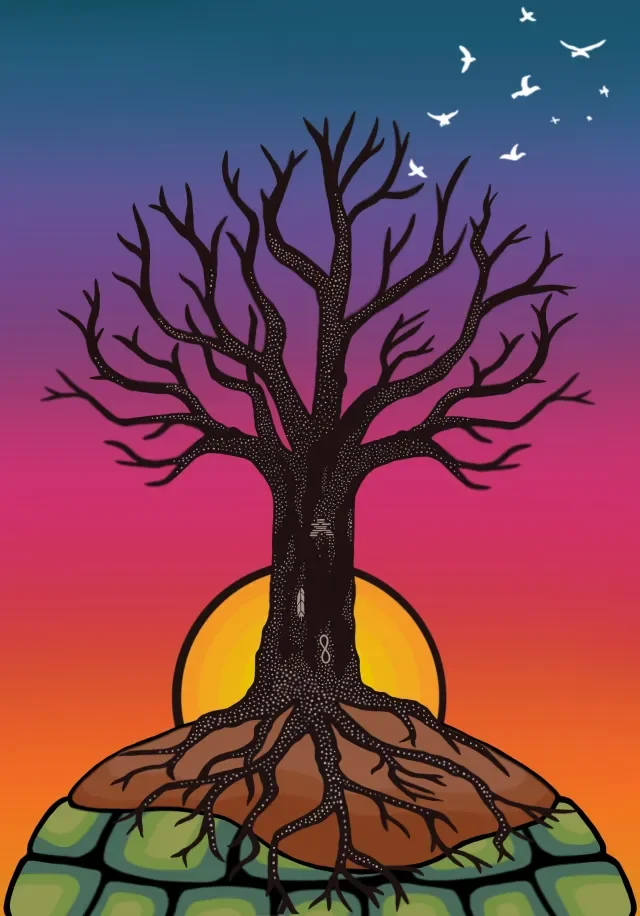
Understanding Gender Based Violence
The Roots of Gender-Based Violence
Violence against Indigenous women and gender-diverse people is deeply connected to colonization, forced assimilation, and cultural genocide. These historic and ongoing harms have created multigenerational patterns of behaviour, beliefs, and attitudes that weaken the well-being of individuals, families, and communities.
According to the United Nations, Gender-Based Violence (GBV) refers to harmful acts directed at a person because of their gender. It is rooted in:
Gender inequality
Abuse of power
Harmful social norms
GBV disproportionately affects women, girls, Two Spirit, trans, and non-binary people. It can include:
Sexual, physical, or emotional abuse
Economic control or deprivation
Threats, coercion, and manipulation
Violence in both public and private spaces
(UWACR, UN Women)
Art by: Lexee Lindberg
“When we are born our spirits are pure and whole. During our journey through life, our spirit may encounter abuse and neglect. Everyone has the right to have their spirit protected, and the responsibility to take care of the sacredness of life.”
— Kanawayhitowin
What GBV Looks Like
Gender-Based Violence includes any harm, behaviour, or practice targeting someone because of their gender identity, gender expression, or perceived gender. This may involve:
Physical violence
Domestic or intimate partner abuse
Sexual assault
Psychological abuse
Cyber abuse or online harassment
Economic abuse or control
GBV is made worse by systemic inequalities such as:
Colonialism and racism
Sexism
Discrimination based on sexual orientation or gender identity
Ableism and classism
Poverty
Collective histories of trauma
GBV is a violation of human rights, an abuse of power, and it is preventable.
Art by: Betty Albert
Signs and Symptoms of GBV
Physical Symptoms
Gender-based violence often leaves visible signs. Common physical symptoms include:
Bruises, burns, fractures, or broken bones
Head injuries and internal injuries
Long-term disabilities such as paralysis, loss of limb function, or brain damage
Severe or fatal injuries, including traumatic brain injury and internal organ damage
Psychological Symptoms
GBV can have deep emotional and mental effects, including:
Trauma and post-traumatic stress disorder (PTSD)
Intense fear, helplessness, or horror
Depression and anxiety, with symptoms like sadness, hopelessness, and trouble sleeping, eating, or concentrating
Panic attacks, obsessive thoughts, or excessive worry about future violence
Substance use as a coping mechanism, which can lead to addiction
Art by: Betty Albert
The Impact of GBV
The effects can be devastating—both immediately and over time—impacting physical health, mental well-being, and relationships. Survivors may experience:
Anxiety and depression
Post-Traumatic Stress Disorder (PTSD)
Difficulty engaging with others, communities, or services
How survivors are treated after the violence is critical to their healing. Insensitive responses from services or systems can cause further harm and slow recovery.
Art by: Serin Alar
Who Is Most at Risk
While violence can affect anyone, certain groups face higher risks due to overlapping forms of oppression, including:
Women and girls
Indigenous women and girls
2SLGBTQQIA+ community members
Gender-diverse individuals
Women in Northern, rural, and remote communities
Women living with disabilities
When multiple risk factors are present, vulnerability to violence increases.
Art by: Simone McLeod
Moving Forward Together
Addressing Gender-Based Violence requires:
Confidentiality (within limits) to build trust
Consistency in action to show long-term commitment
Community tools and resources—like this toolkit—to support change
Art by: Simone McLeod
Statistics on Gender-Based Violence
(Sources: Statistics Canada, 2021; Government of Canada; Canadian Women’s Foundation; National Inquiry into MMIWG, and others)
Prevalence of Gender-Based Violence
Women in Canada are more likely than men to experience Intimate Partner Violence (IPV).
44% of women report experiencing some form of IPV in their lifetime (since age 15).
Nearly 1 in 3 women worldwide experience GBV (The World Bank).
65% of Canadians know a woman who has experienced physical, sexual, or emotional abuse.
Impact on Marginalized Groups
LGB+ women: 67% have experienced IPV since age 15 (vs. 44% for heterosexual women).
Indigenous women: 6–10 in every 10 have experienced IPV in their lifetime.
Indigenous women and girls are 12× more likely to be murdered or go missing than other women in Canada.
Rural women: Rates of IPV are 75% higher than urban women.
2SLGBTQQIA+ community:
Twice as likely to experience sexual assault.
Less likely to report assaults to police.
Higher risk of depression, anxiety, and substance abuse.
Transgender people: More likely to experience violence since age 15 and inappropriate behaviours in public, online, and at work.
Lethal and Severe Violence
Every 6 days a woman in Canada is killed by her intimate partner.
Cyber & Technology-Facilitated Violence
Digital abuse is a growing form of GBV, including online threats, harassment, and stalking.
67% of those reporting online intimidation to police are women and girls.
1 in 5 women report experiencing online harassment.
Girls and gender-diverse people face the most severe harassment and sexualized abuse online.
Global survey on online abuse impact (Plan International):
24% felt physically unsafe.
42% felt mentally/emotionally distressed.
42% lost self-confidence.
18% had problems at school.
7% had difficulty finding/keeping a job.
19% used social media less.
12% stopped using social media entirely.






